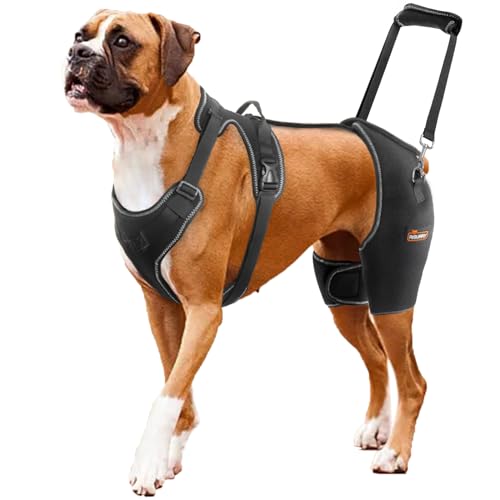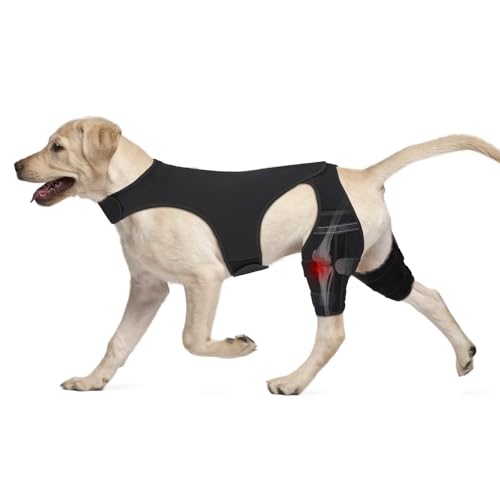
Introduction Hip dysplasia is a common orthopedic condition affecting dogs of all sizes, leading to discomfort, mobility issues, and, in severe cases, arthritis. While it is more prevalent in larger breeds, small and medium-sized dogs can also suffer from this condition. This guide provides an in-depth look at hip dysplasia, its causes, symptoms, treatment options, and preventive measures to ensure your dog stays healthy and active.
What is Hip Dysplasia?

Hip dysplasia is a genetic and developmental condition in which the hip joint does not fit into the hip socket properly, causing instability and degeneration over time. This can lead to pain, limping, and reduced mobility in affected dogs.
Common Causes of Hip Dysplasia:
- Genetics: Inherited traits play a significant role in susceptibility.
- Poor Nutrition: Overfeeding and unbalanced diets can exacerbate joint issues.
- Rapid Growth: Excessive weight gain during puppyhood increases stress on developing joints.
- Lack of Exercise: Insufficient or excessive exercise can impact joint health.
Breeds Prone to Hip Dysplasia

Small Dog Breeds:
- French Bulldog
- Pug
- Boston Terrier
- Dachshund
- Shih Tzu
- Pekingese
- Cavalier King Charles Spaniel
- Bichon Frise
- Chihuahua
- Miniature Poodle
Medium Dog Breeds:
- Cocker Spaniel
- Border Collie
- Basset Hound
- American Bulldog
- Australian Shepherd
- Beagle
- English Springer Spaniel
- Staffordshire Bull Terrier
- Pembroke Welsh Corgi
- Whippet
Large Dog Breeds:
- German Shepherd
- Rottweiler
- Labrador Retriever
- Golden Retriever
- Saint Bernard
- Great Dane
- Bernese Mountain Dog
- Mastiff
- Doberman Pinscher
- Alaskan Malamute
Symptoms of Hip Dysplasia
- Difficulty standing up or sitting down
- Reluctance to jump, run, or climb stairs
- Limping or swaying gait
- Decreased activity levels
- Stiffness, especially after resting
- Audible clicking sounds from joints
- Muscle loss in hind legs
Diagnosis and Veterinary Evaluation

A veterinarian may use the following methods to diagnose hip dysplasia:
- Physical Examination: Checking for pain and limited range of motion.
- X-Rays: Identifying joint malformation and degenerative changes.
- Hip Scoring Tests: Assessing joint stability and function.
- Gait Analysis: Observing how the dog moves to detect abnormalities.
Treatment Options for Hip Dysplasia

1. Non-Surgical Treatments
For mild to moderate cases, conservative management can significantly improve a dog’s quality of life.
- Weight Management: Keeping your dog at a healthy weight reduces stress on joints.
- Joint Supplements: Glucosamine and chondroitin support cartilage health.
- Physical Therapy: Hydrotherapy, massage, and stretching exercises help improve mobility.
- Anti-Inflammatory Medications: Non-steroidal anti-inflammatory drugs (NSAIDs) relieve pain and inflammation.
- Orthopedic Beds & Supportive Gear: Special dog beds and braces reduce discomfort.
- Acupuncture & Laser Therapy: Alternative treatments that help with pain management.
2. Surgical Treatments
In severe cases, surgery may be required to improve mobility and reduce pain.
- Femoral Head Ostectomy (FHO): Removes the head of the femur to create a pain-free joint.
- Total Hip Replacement (THR): Replaces the entire hip joint with an artificial one.
- Double or Triple Pelvic Osteotomy (DPO/TPO): Reshapes the hip socket for better stability (ideal for young dogs).
- Juvenile Pubic Symphysiodesis (JPS): A preventative procedure done in puppies to alter hip growth and reduce dysplasia risk.
Preventing Hip Dysplasia in Dogs
- Choose a Responsible Breeder: Ensure parents have been screened for hip dysplasia.
- Provide a Balanced Diet: Proper nutrition supports joint and bone health.
- Maintain an Active Lifestyle: Moderate exercise strengthens muscles without straining joints.
- Avoid Overfeeding: Excess weight increases stress on joints.
- Use Joint Supplements Early: Preventative use of glucosamine and omega-3 fatty acids can help.
- Regular Veterinary Check-Ups: Early detection allows for timely
- intervention.
Click on the link:
- UPGRADED DOG HIP BRACE: Furtent dog hip brace adding removable protective cotton pads on the sides of the legs can bette…
- HIGH QUALITY TO WEAR:Dog hip brace combines professional-grade materials for reliability and comfort. The ultra-thin 1mm…
- SAFETY AND AESTHETICS: Designed with both safety and style in mind, the collar to connect hip support features a reflect…
- HIP SUPPORT:The Hip Brace for Dogs provides support for dogs suffering from hip osteoarthritis, hip dysplasia and other …
- PAIN RELIEF: Hip Brace for dogs with hip osteoarthritis, Hip dysplasia and hind leg lameness provide relief and support …
- EASY TO WEAR: One-touch adhesive wear design reduces dog resistance. And the product comes with left and right leg marki…
- Enhanced Mobility and Pain Relief: Maximize your dog’s comfort and mobility with our dog brace, designed to alleviate pa…
- Robust Knee Brace Support: Featuring metal stabilizers, our dog ACL brace is crafted to snugly fit your dog’s knee joint…
- Secure Fit, No More Slipping: Say goodbye to slipping with our integrated dog knee brace and vest set. Crafted from soft…
- Support for ACL Tears and Joint Injuries: This dog knee brace provides effective support for ACL tears, ligament injurie…
- Ideal for Arthritis and Hip Dysplasia: Designed for arthritis pain relief and managing hip dysplasia, this versatile bra…
- Adjustable and Secure Fit: Features adjustable straps for a snug and customizable fit, ensuring stability during wear. T…
CHAMIN/RISURRY Dog Hip Brace Support for Hip Dysplasia, Arthritis, Back Leg limping, Rear Leg Brace with Back Handheld Design to Reduce Hip Pain et(Large)
Hip dysplasia is a common orthopedic condition in dogs, particularly affecting larger breeds. Here are 10 fascinating facts about this condition:
1. Genetic and Environmental Factors
While hip dysplasia has a genetic component, environmental factors such as diet, exercise, and weight management also play significant roles in its development. Vca
2. Early Onset Possible
Signs of hip dysplasia can appear as early as four months of age. Early detection is crucial for effective management.
3. Common in Large Breeds
Large and giant breeds like German Shepherds, Labrador Retrievers, and Great Danes are more susceptible to hip dysplasia, though it can occur in smaller breeds as well. Wikipedia+1American Kennel Club+1
4. Symptoms Vary
Symptoms include decreased activity, difficulty rising, lameness in the hind limbs, and a swaying gait. Wikipedia+1mobilecatanddogvet.com+1
5. Diagnosis Through Imaging
Veterinarians diagnose hip dysplasia using radiographs (X-rays) to assess the hip joint’s structure and identify any abnormalities. ceracnyu.blob.core.windows.net+1American Kennel Club+1
6. Treatment Options Vary
Treatment ranges from weight management and physical therapy to surgical interventions like total hip replacement, depending on severity.
7. Preventive Measures
Maintaining a healthy weight, providing appropriate exercise, and avoiding excessive jumping in young dogs can help prevent hip dysplasia. Vca
8. Impact on Quality of Life
If left untreated, hip dysplasia can lead to chronic pain and decreased mobility, significantly affecting a dog’s quality of life.
9. Advancements in Supportive Devices
Innovations like specialized harnesses are being developed to support dogs with hip dysplasia, aiding in mobility and comfort. WIRED
10. Regular Veterinary Check-Ups Are Essential
Routine veterinary visits are crucial for early detection and management of hip dysplasia, ensuring better outcomes for affected dogs.
Understanding hip dysplasia’s causes, symptoms, and treatment options is vital for dog owners, especially those with large breeds. Early intervention and proper care can significantly improve the quality of life for dogs affected by this condition.
Conclusion
Hip dysplasia can affect dogs of all sizes, but with proper care, early detection, and treatment, affected dogs can still live happy, active lives. Whether through preventative measures, conservative treatments, or surgery, managing hip dysplasia effectively ensures your dog’s well-being.
For more pet health tips and expert advice, stay tuned to our blog!
- Optimal Mobility: Enhance your canine’s vitality with our Glucosamine-rich joint supplement for dogs, crafted for hip an…
- Customer Care: Invest in your dog’s joint health with our joint support supplement, backed by a 90-day guаrаntеe for a h…
- Tasty Treats: Unlike pills, capsules, or tablets, this glucosamine chondroitin for dogs is a delicious soft & natural tr…
- Ease joint stiffness associated with daily activity with natural ingredients – Turmeric has been used for centuries as a…
- Gentle & natural for your pup – At Pet Honesty we’re committed to premium quality ingredients and strict safety standard…
- Right amount of actives + no fillers – Some turmeric curcumin soft chew supplements for dogs have unusually high amounts…
- VETERINARIAN RECOMMENDED – Formulated by Dr. Joseph, a veterinarian with over 30 years of experience relieving his patie…
- 5X MORE GLUCOSAMINE – Damage to the joints and the surrounding tissue are common injuries for dogs and cats. Our dog hip…
- RELIEF FROM INFLAMMATION – If your dogs or cats love to play, then they’ll likely end up with painful swelling in their …
- Joint Health Support for Dogs: Cosequin, the veterinarian recommended retail joint health supplement brand, contains glu…
- Easy to Serve: Cosequin Maximum Strength Joint Health Supplements come in tasty chewable tablets and soft chews for dogs…
- Manufactured in the United States with Globally Sourced Ingredients: Cosequin is a high-quality, dog joint supplement










Leave a Reply